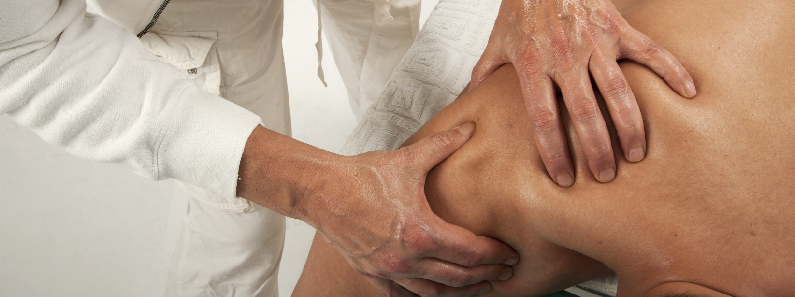
After an injury or surgery, an exercise conditioning program will help you return to daily activities and enjoy a more active, healthy lifestyle. To ensure that the program is safe and effective for you, it should be performed under your doctor's supervision. Talk to your doctor or physical therapist about which exercises will best help you meet your rehabilitation goals.
There are many exercises which will help you meet your rehabilitation goals.
Main Muscles : Deltoids, supraspinatus, infraspinatus, subscapularis
Equipment Needed : None
Repetitions : 2 sets of 10
Days per week : 5 to 6
~ Lean forward and place one hand on a counter or table for
support. Let your other arm hang freely at your side.
~ Gently swing your arm forward and back. Repeat the exercise
moving your arm side-to-side, and repeat again in a circular
motion.
~ Repeat the entire sequence with the other arm.
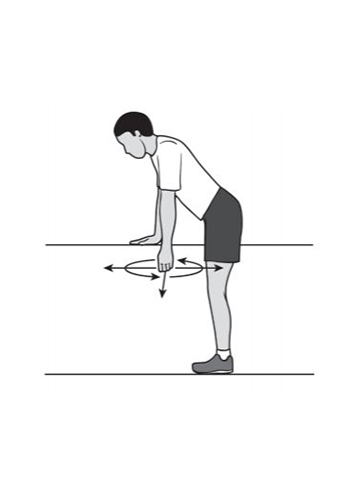
Main Muscles : Posterior deltoid
Equipment Needed : None
Repetitions : 4 each side
Days per week : 5 to 6
~ Relax your shoulders and gently pull one arm across your chest as far as
possible, holding at your upper arm.
~ Hold the stretch for 30 seconds and then relax for 30 seconds.
~ Repeat with the other arm.
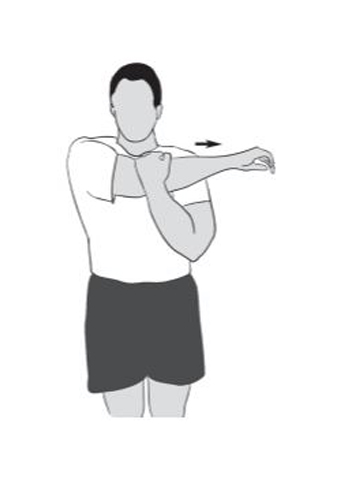
Main Muscles : Subscapularis
Equipment Needed : Light stick, such as a yardstick
Repetitions : 4 each side
Days per week : 5 to 6
~ Hold a stick behind your back with one hand, and lightly
grasp the other end of the stick with your other hand.
~ Pull the stick horizontally as shown so that your shoulder is
passively stretched to the point of feeling a pull without pain.
~ Hold for 30 seconds and then relax for 30 seconds.
~ Repeat on the other side.

Main Muscles : Infraspinatus, teres minor
Equipment Needed : Light stick, such as a yardstick
Repetitions : 4 each side
Days per week : 5 to 6
~ Grasp the stick with one hand and cup the other end of the
stick with the other hand.
~ Keep the elbow of the shoulder you are stretching against
the side of your body and push the stick horizontally as
shown to the point of feeling a pull without pain.
~ Hold for 30 seconds and then relax for 30 seconds.
~ Repeat on the other side.
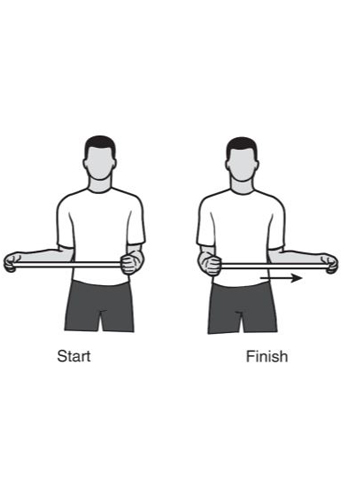
Main Muscles : Infraspinatus, teres minor
Equipment Needed : None
Repetitions : 4 reps, 3x a day
Days per week : Daily
~ Lie on your side on a firm, flat surface with the affected
shoulder under you and your arm bent, as shown. You can
place your head on a pillow for comfort, if needed.
~ Use your unaffected arm to push your other arm down. Stop
pressing down when you feel a stretch in the back of your
affected shoulder.
~ Hold this position for 30 seconds, then relax your arm for
30 seconds.
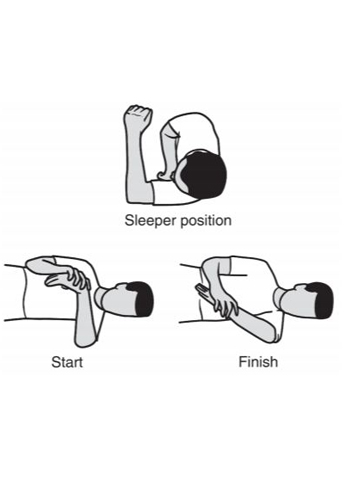
Main Muscles : Middle and lower trapezius
Equipment Needed : Elastic stretch band of comfortable resistance
Repetitions : 3 sets of 8
Days per week : 3
~ Make a 3-foot-long loop with the elastic band and tie the ends
together. Attach the loop to a doorknob or other stable object.
~ Stand holding the band with your elbow bent and at your side, as
shown in the start position.
~ Keep your arm close to your side and slowly pull your elbow
straight back.
~ Slowly return to the start position and repeat.
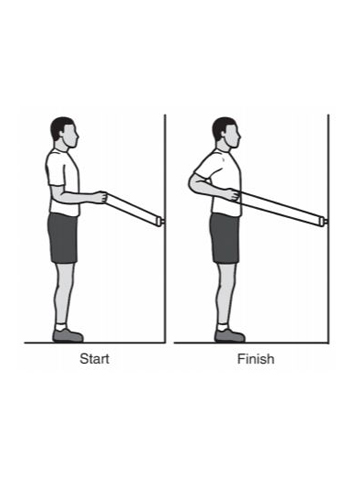
Main Muscles : Infraspinatus and teres minor
Equipment Needed : Elastic stretch band of comfortable resistance
Repetitions : 3 sets of 8
Days per week : 3
~ Make a 3-foot-long loop with the elastic band and tie the ends
together. Attach the loop to a doorknob or other stable object.
~ Stand holding the band with your elbow bent 90° and raised to
shoulder-height, as shown in the start position.
~ Keeping your shoulder and elbow level, slowly raise your hand
until it is in line with your head.
~ Slowly return to the start position and repeat.
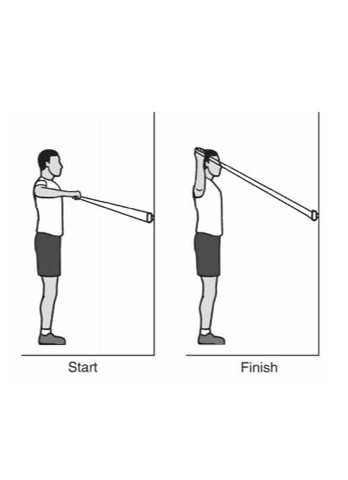
Main Muscles : Biceps
Equipment Needed : Begin with a weight that allows 3 sets of 8 repetitions and progress to 3 sets of 12 repetitions.
Repetitions : 3 sets of 8
Days per week : 3
~ Stand tall with your weight evenly distributed over both feet.
~ Keep your elbow close to your side and slowly bring the weight up
toward your shoulder as shown.
~ Hold for 2 seconds.
~ Slowly return to the starting position and repeat.

Main Muscles : Triceps
Equipment Needed : Begin with a weight that allows 3 sets of 8 repetitions and progress to 3 sets of 12 repetitions.
Repetitions : 3 sets of 8
Days per week : 3
~ Stand tall with your weight evenly distributed over both feet.
~ Raise your arm and bend your elbow with the weight behind your head.
Support your arm by placing your opposite hand on your upper arm.
~ Slowly straighten your elbow and bring the weight overhead.
~ Hold for 2 seconds.
~ Slowly lower your arm back down behind your head and repeat.
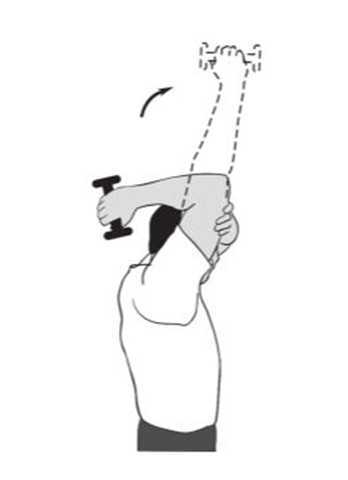
Main Muscles : Middle and posterior deltoid, supraspinatus, middle trapezius
Equipment Needed : Begin with a light enough weight to allow 3 to 4 sets of 20 repetitions without pain.
Repetitions : 3 sets of 20
Days per week : 3 to 5
~ Place your knee on a bench or chair and lean forward so that your hand reaches the bench and helps support your weight. Your other hand is at your side, palm facing your body.
~ Slowly raise your arm, rotating your hand to the thumbs-up position and stopping when your hand is shoulder height, with your arm parallel to the floor.
~ Slowly lower your arm to the original position to a count of 5.
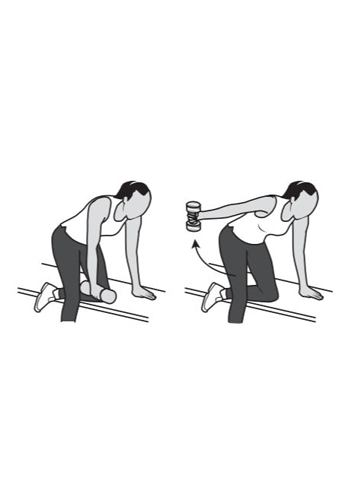
Main Muscles : Middle trapezius, serratus
Equipment Needed : None
Repetitions : 10
Days per week : 3
~ Lie on your stomach with your arms by your sides.
Place a pillow under your forehead for comfort, if required.
~ Gently draw your shoulder blades together and down your back as
far as possible.
~ Ease about halfway off from this position and hold for 10 seconds.
~ Relax and repeat 10 times.
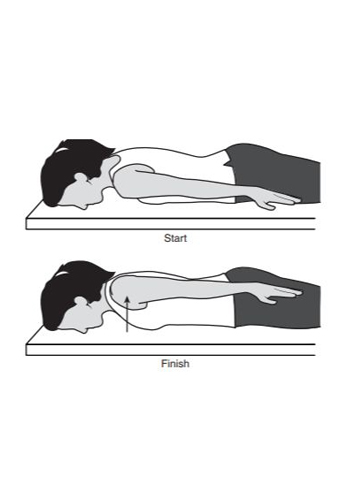
Main Muscles : Middle trapezius, serratus
Equipment Needed : Begin with a weight that allows 2 sets of 8 repetitions and progress to 3 sets of 15 repetitions.
Repetitions : 2 sets of 8
Days per week : 3
~ Lie on your stomach on a table or bed with your injured arm
hanging over the side.
~ Keep your elbow straight and lift the weight slowly by
squeezing your shoulder blade toward the opposite side
as far as possible.
~ Return slowly to the starting position and repeat.
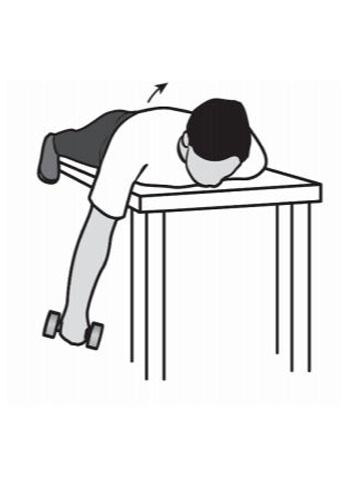
The small puncture wounds take several days to heal. The operative dressing can usually be removed the morning after surgery and adhesive strips can be applied to cover the small healing incisions.
Although the puncture wounds are small and pain in the joint that underwent arthroscopy is minimal, it takes several weeks for the joint to maximally recover. A specific activity and rehabilitation program may be suggested to speed your recover and protect future joint function.